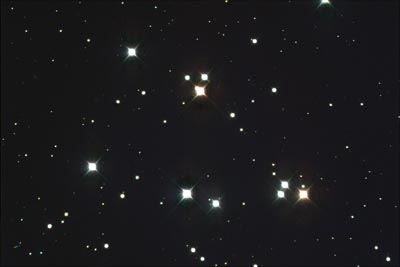You will certainly have to view the larger versions of this image to appreciate the details of this portrait. The Beehive cluster as it is also called has been traditionally used for a test of vision and/or sky transparency. According to Vehrenberg, it cannot be resolved with the naked eye, but appears as a very faint haze whose visibility is determined by the sky. Hans didn't live in Arizona. Here, we can easily see a dozen cluster members to the naked eye, and it is a bright beacon of a deep sky object in the early spring skies. The curious central part of the cluster is shown here, most of it lying outside the field. Three objects of interest can be seen in the high resolution images. There are two 16th magnitude galaxies, one to the upper left with some structure and one to the right of center. Also, as is becoming more common in my more recent images, an asteroid made its presence known by the telltale RGBB streak on the lower left corner of the image. It is magnitude 15.5 as well. Instrument: 12.5" f/5 Home made Newtonian Platform: Astrophysics 1200 QMD CCD Camera: SBIG ST8i NABG Guider: SBIG ST4 Exposure: RGBB = 20:20:40 RGB Combine Ratio: 1: .8: 1.2 Filters: RGB Tricolor Location: Payson, Arizona Elevation: 5150 ft. Sky: Seeing FWHM = 4 arcsec (Maxim DL - 10min subframe), Transparency 5/10 Outside Temperature: 6 C CCD Temperature: -20 C Processing Tools: Maxim DL, RG Sigma, Photoshop, AIP4WIN, RW Debloomer.
|
||||
|
|
||||
|
FastCounter by bCentral |
